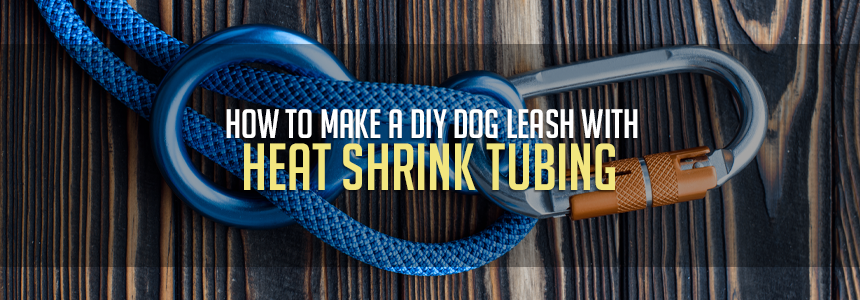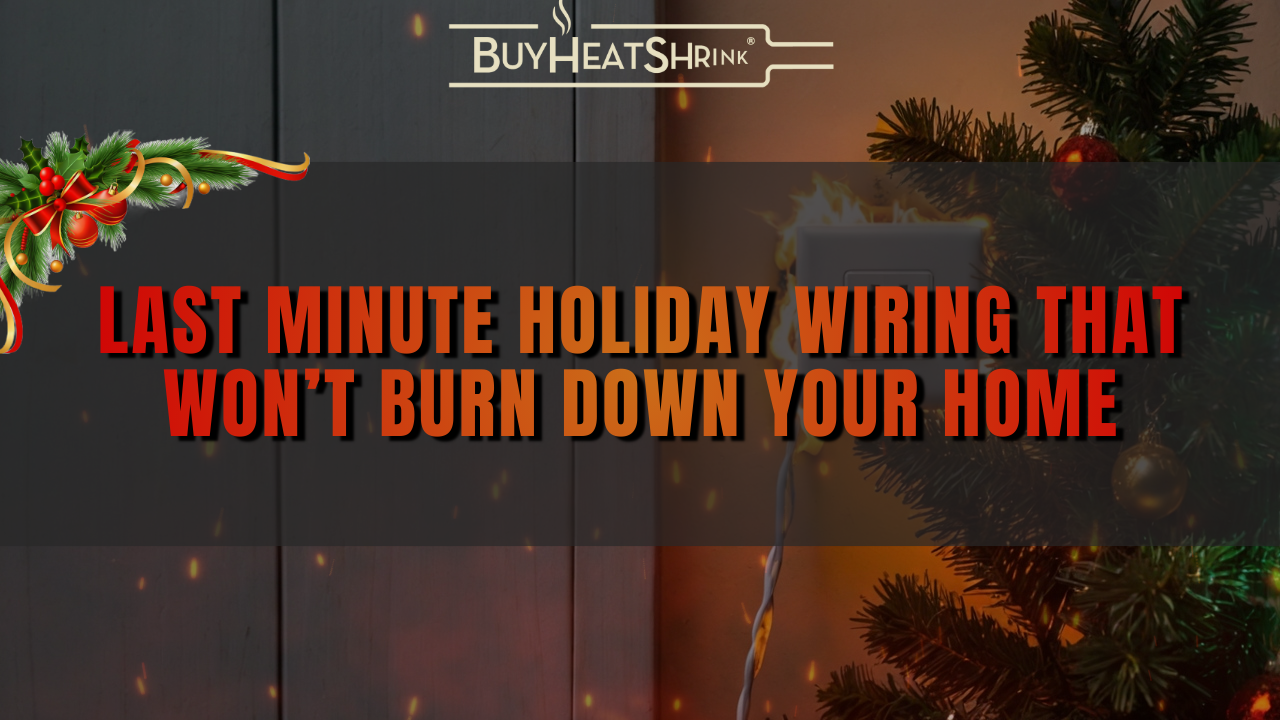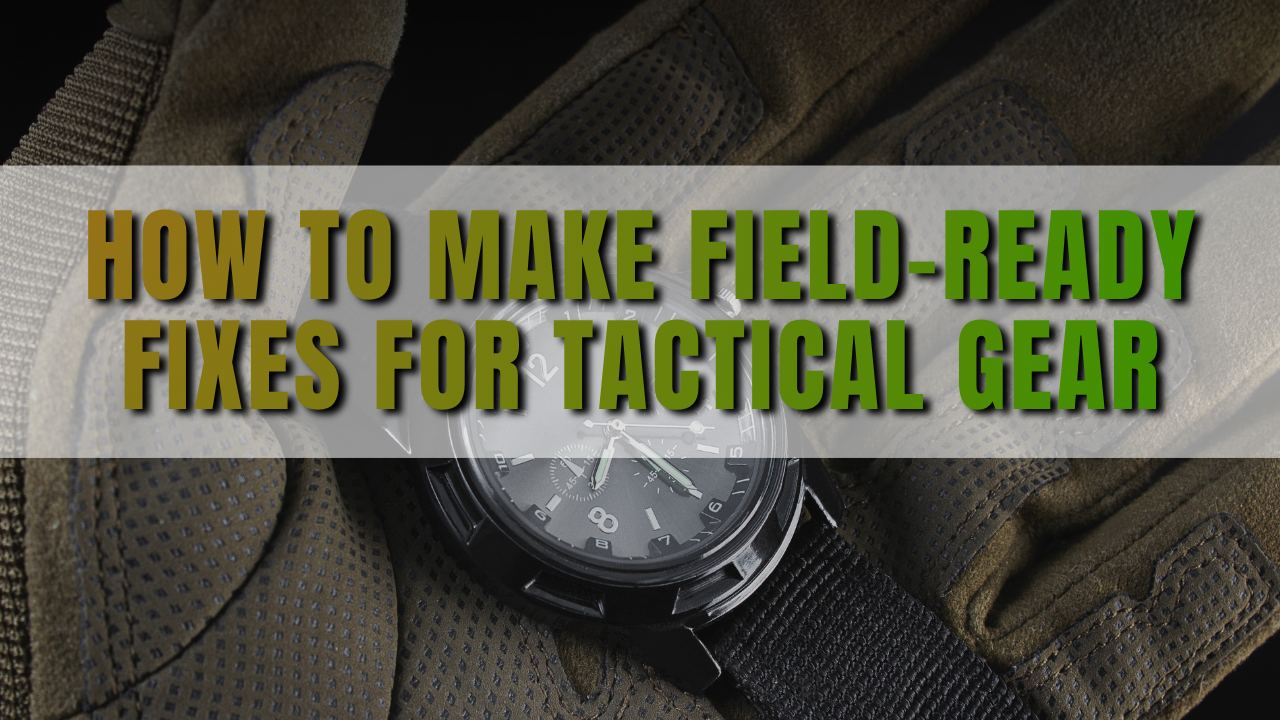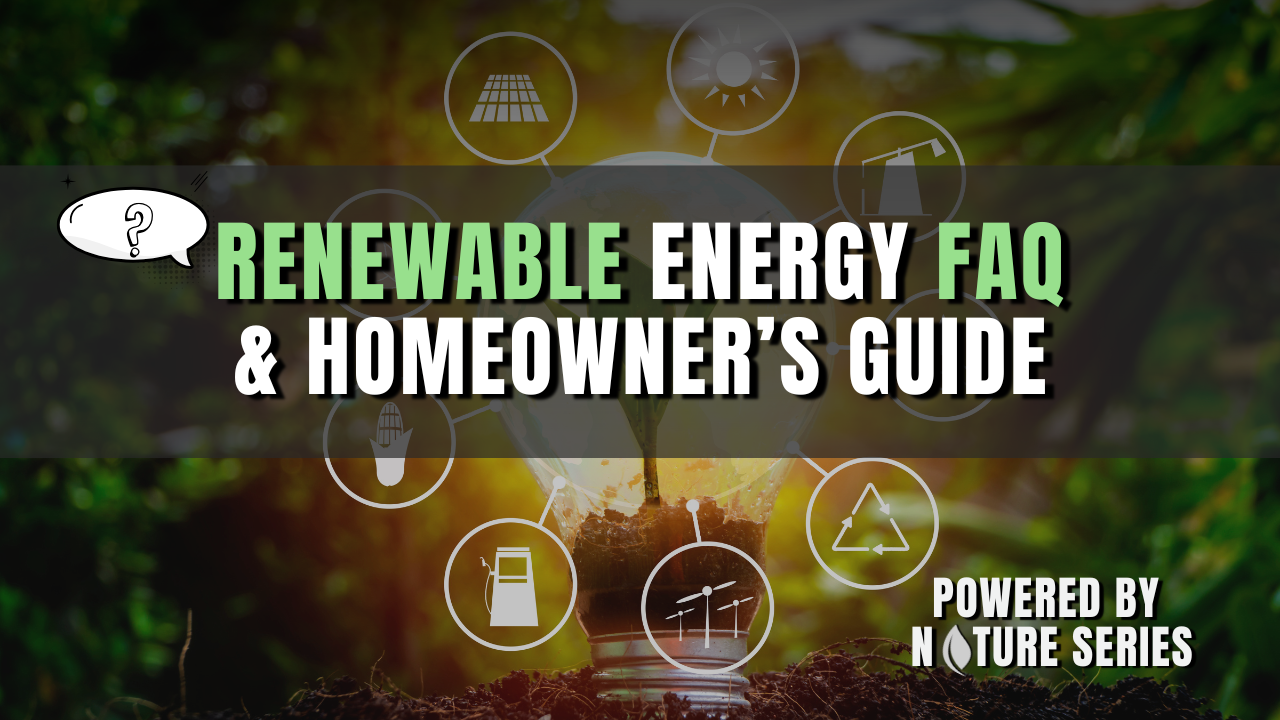Types of Heat Shrink: What They Are, and What They’re For

Heat shrink tubing is an essential material for protecting, insulating, and organizing electrical wiring across industries. This guide covers everything you need to know about heatshrink—from the most common material types (polyolefin, fabric, PVC, PTFE) to the differences between single- and double-walled options, shrink ratios, and other performance characteristics such as flexibility, fire resistance, dielectric strength, and resistance to water, chemicals, and UV exposure. Whether you’re working on automotive wiring, marine applications, or electronics, this article will help you choose the best heat shrink tubing for your project.
What is Heat Shrink Tubing?
Heat shrink usually refers to tubing that contracts when heated. It works for applications such as insulating or protecting and organzing the wiring. As the tube tightens around the wire, it can secure connections, avoid tangling, and insulate against shocks or short-circuits.
This general label, however, covers a wide variety of issues. At BuyHeatShrink, we offer one of the widest selections of heat shrink tubing in the industry and want to make sure that every customer gets the best type of heat shrink for their application.
The good news is that this is relatively easy. If you understand the different types of heat shrink, you can select what works best for your application.
Usually, heat shrink is classified according to its material — whether it has single- or double-walled construction — or its shrink ratio. Then you want to take account of a few other factors before looking closely at the application.
Heat Shrink Material Types
There are many potential materials for heat shrink. Some are uncommon and expensive. The most common and widely available types of heat shrink are:
Polyolefin is the most common kind of heat shrink material, in part because its properties make it a great choice for most applications. It comes in a variety of colors. Shrink temperature is 120° C (229° F), and the material can perform continuously between temperatures of -55° C to +135° C (-67° F to +275° F). However, most polyolefin heat shrink is not UV resistant.
Fabric heat shrink is a woven blend of materials, a combination of polyolefin and polyester. The woven structure makes it highly flexible while allowing it to retain strength and abrasion resistance. It has a low shrink temperature, 80° C (176° F), but a narrower range of operating temperatures, -40° C to +125° C (-40° F to +270° F). It also shrinks more longitudinally (lengthwise) than other heat shrinks.
Polyvinylchloride (PVC) is often used as a low-cost alternative to other heat-shrink materials. As an inert material, it’s good for food and drink applications. Its high UV resistance makes it a great choice for exposed applications. However, it does have some limitations, such as sensitivity to high temperatures. Standard PVC tubing is also widely used as a general-purpose insulating sleeve when heat activation isn’t needed. The shrink temperature for PVC is 100° C (212° F), and the range of operating temperatures is -55° C to 105° C (-67° F to +221° F). We do not ship this material without written authorization during the warmer months because of its heat sensitivity.
Polytetrafluoroethylene (PTFE AKA Teflon) is heat shrink tubing used when an application requires a high-temperature operation. PTFE tubing can operate safely at temperatures ranging from -67° C to +250° C (-88° F to +482° F). The shrink temperature of 340° C (644° F) also makes it hard for most people to use this material in standard applications.
Single-Walled vs. Double-Walled Heat Shrink
It’s also useful to understand the difference between the single-walled and double-walled types of heat shrink.
Single-walled heat shrink is a single layer of material that can be of any thickness. It is easy to handle and sufficient for most applications.
Double-walled heat shrink has an inner layer that melts, often called the adhesive layer. This not only binds the heat shrink to the wiring, but also provides a better seal against moisture. It’s recommended for moist or wet applications.
Heat Shrink Ratios
Most heat shrink tubing is designed with a simple 2:1 shrink ratio. In other words, the internal diameter of the tube, after shrinking, called recovery, will be half that of the tube’s initial diameter.
However, other ratios are available — 3:1, 4:1, and even 6:1.
Always choose heat shrink whose fully recovered diameter is smaller than the diameter of the wiring bundle, connection, or tubing you want to coat. Larger compression ratios give you additional freedom when working with wires or tubes with large connectors.
Other Characteristics
When considering your heat shrink, take into account other characteristics of the material, such as:
Flexibility: most heat shrink material is flexible, with the exception of PTFE, and some other, less common materials. However, shrinkable fabric has the highest flexibility.
Fire resistance: Most heat shrink material is flame retardant. Even fabric, which is considered the least flame retardant, passes the FMVSS 302 Horizontal Burn Test. However, as with UV resistance, this is affected by color. Clear polyolefin is not flame retardant, for example.
Dielectric strength: one of the functions of heat shrink is protecting components from electromagnetic and radiofrequency interference (EMI/RFI). The dielectric strength of the material defines the level of protection. PTFE has the highest dielectric strength, followed by polyolefin.
Finding the Best Type of Heat Shrink for your Application
When it comes time to select heat shrink for your project, you should take many factors into account, such as:
- Shrink temperature
- Operating temperature
- Voltage
- Chemical exposure
- UV exposure
- Water exposure
The main concern about shrink temperature is whether you will damage the components you are trying to protect during the shrinking process. You don’t want something with a shrink temperature that’s too high. On the other hand, you want to make sure that the shrink temperature is significantly above your operating temperature. When operating at or above the shrink temperature, the heat shrink can degrade or fail catastrophically.
Make sure that you are using heat shrink that can insulate against the voltage being used. Most common heat shrinks readily insulate against 600 V but check before selecting heat shrink for wiring.
Some heat shrink is chemically resistant to common chemicals used in automotive applications. Hydraulic or brake fluid, antifreeze, oil, and gasoline will not harm them. Even battery acid won’t damage heat shrink. However, some polyolefins are vulnerable to damage by diesel fuels, gasoline, and mineral oil, so you will need to research carefully to find the right heat shrink for applications where they might be exposed.
UV radiation can break down many polymers, including some types of heat shrink. Polyolefins are notably vulnerable to UV radiation — only black polyolefins are resistant to UV. Consider PVC for applications with UV exposure.
When an application leads to water exposure, it is best to select a double-walled heat shrink. This creates a tight seal that prevents water infiltration and avoids corrosion and short-circuits.
Some Example Applications
If you are looking for heat shrink to use on wiring in an automotive application, you would have to consider where you were using it. If the wiring is protected from UV radiation, such as inside or under the car, then polyolefin heat shrink will work well, as long as the wiring would not regularly be exposed to mineral oil, gasoline, or diesel fuel. For applications exposed to UV, you can either select a black polyolefin or choose PVC.
In most cases, single-walled heat shrink is suitable for automotive applications. However, if the wiring will be regularly exposed to water, such as inside a wheel well, then a double-walled heat shrink would be a better choice.
On the other hand, if you are considering heat shrink for boat wiring, you might want to favor double-walled heat shrink as your default, depending on the location of the wiring and how much it is likely to be exposed directly to water. Otherwise, considerations remain similar.
For motorcycle wiring, the need to work in tight spaces might make the high flexibility of fabric heat shrink desirable. Or perhaps you will want a heat shrink with a higher compression ratio so that you have the freedom to work with wires outside the bike but have them shrink down to fit easily inside the space when you are finished.
Have More Questions about Heat Shrink?
Hopefully, this guide has helped you understand all you need to know to choose the best type of heat shrink tubing for your application. Set up an account or log in to put in an order.
If you have additional questions, visit our learning center or FAQs. Or you can contact us here with questions or to receive a sample.
Heat shrink usually refers to tubing that contracts when heated. It works for applications such as insulating or protecting the wiring. As the tube tightens around the wire, it can secure connections, avoid tangling, and insulate against shocks or short-circuits.
This general label, however, covers a wide variety of issues. At BuyHeatShrink, we offer one of the widest selections of heat shrink tubing in the industry and want to make sure that every customer gets the best type of heat shrink for their application.
The good news is that this is relatively easy. If you understand the different types of heat shrink, you can select what works best for your application.
Usually, heat shrink is classified according to its material — whether it has single- or double-walled construction — or its shrink ratio. Then you want to take account of a few other factors before looking closely at the application.
Heat Shrink Material Types
There are many potential materials for heat shrink. Some are uncommon and expensive. The most common and widely available types of heat shrink are:
Polyolefin is the most common kind of heat shrink material, in part because its properties make it a great choice for most applications. It comes in a variety of colors. Shrink temperature is 120° C (229° F), and the material can perform continuously between temperatures of -55° C to +135° C (-67° F to +275° F). However, most polyolefin heat shrink is not UV resistant.
Fabric heat shrink is a woven blend of materials, a combination of polyolefin and polyester. The woven structure makes it highly flexible while allowing it to retain strength and abrasion resistance. It has a low shrink temperature, 80° C (176° F), but a narrower range of operating temperatures, -40° C to +125° C (-40° F to +270° F). It also shrinks more longitudinally (lengthwise) than other heat shrinks.
Polyvinylchloride (PVC) is often used as a low-cost alternative to other heat-shrink materials. As an inert material, it’s good for food and drink applications. Its high UV resistance makes it a great choice for exposed applications. However, it does have some limitations, such as sensitivity to high temperatures. The shrink temperature for PVC is 100° C (212° F), and the range of operating temperatures is -55° C to 105° C (-67° F to +221° F). We do not ship this material without written authorization during the warmer months because of its heat sensitivity.
Polytetrafluoroethylene (PTFE AKA Teflon) is heat shrink tubing used when an application requires a high-temperature operation. PTFE tubing can operate safely at temperatures ranging from -67° C to +250° C (-88° F to +482° F). The shrink temperature of 340° C (644° F) also makes it hard for most people to use this material in standard applications.
Single-Walled vs. Double-Walled Heat Shrink
It’s also useful to understand the difference between the single-walled and double-walled types of heat shrink.
Single-walled heat shrink is a single layer of material that can be of any thickness. It is easy to handle and sufficient for most applications.
Double-walled heat shrink has an inner layer that melts, often called the adhesive layer. This not only binds the heat shrink to the wiring, but also provides a better seal against moisture. It’s recommended for moist or wet applications.
Heat Shrink Ratios
Most heat shrink tubing is designed with a simple 2:1 shrink ratio. In other words, the internal diameter of the tube, after shrinking, called recovery, will be half that of the tube’s initial diameter.
However, other ratios are available — 3:1, 4:1, and even 6:1.
Always choose heat shrink whose fully recovered diameter is smaller than the diameter of the wiring bundle, connection, or tubing you want to coat. Larger compression ratios give you additional freedom when working with wires or tubes with large connectors.
Other Characteristics
When considering your heat shrink, take into account other characteristics of the material, such as:
Flexibility: most heat shrink material is flexible, with the exception of PTFE, and some other, less common materials. However, shrinkable fabric has the highest flexibility.
Fire resistance: Most heat shrink material is flame retardant. Even fabric, which is considered the least flame retardant, passes the FMVSS 302 Horizontal Burn Test. However, as with UV resistance, this is affected by color. Clear polyolefin is not flame retardant, for example.
Dielectric strength: one of the functions of heat shrink is protecting components from electromagnetic and radiofrequency interference (EMI/RFI). The dielectric strength of the material defines the level of protection. PTFE has the highest dielectric strength, followed by polyolefin.
Finding the Best Type of Heat Shrink for your Application
When it comes time to select heat shrink for your project, you should take many factors into account, such as:
- Shrink temperature
- Operating temperature
- Voltage
- Chemical exposure
- UV exposure
- Water exposure
The main concern about shrink temperature is whether you will damage the components you are trying to protect during the shrinking process. You don’t want something with a shrink temperature that’s too high. On the other hand, you want to make sure that the shrink temperature is significantly above your operating temperature. When operating at or above the shrink temperature, the heat shrink can degrade or fail catastrophically.
Make sure that you are using heat shrink that can insulate against the voltage being used. Most common heat shrinks readily insulate against 600 V but check before selecting heat shrink for wiring.
Some heat shrink is chemically resistant to common chemicals used in automotive applications. Hydraulic or brake fluid, antifreeze, oil, and gasoline will not harm them. Even battery acid won’t damage heat shrink. However, some polyolefins are vulnerable to damage by diesel fuels, gasoline, and mineral oil, so you will need to research carefully to find the right heat shrink for applications where they might be exposed.
UV radiation can break down many polymers, including some types of heat shrink. Polyolefins are notably vulnerable to UV radiation — only black polyolefins are resistant to UV. Consider PVC for applications with UV exposure.
When an application leads to water exposure, it is best to select a double-walled heat shrink. This creates a tight seal that prevents water infiltration and avoids corrosion and short-circuits.
Some Example Applications
If you are looking for heat shrink to use on wiring in an automotive application, you would have to consider where you were using it. If the wiring is protected from UV radiation, such as inside or under the car, then polyolefin heat shrink will work well, as long as the wiring would not regularly be exposed to mineral oil, gasoline, or diesel fuel. For applications exposed to UV, you can either select a black polyolefin or choose PVC.
In most cases, single-walled heat shrink is suitable for automotive applications. However, if the wiring will be regularly exposed to water, such as inside a wheel well, then a double-walled heat shrink would be a better choice.
On the other hand, if you are considering heat shrink for boat wiring, you might want to favor double-walled heat shrink as your default, depending on the location of the wiring and how much it is likely to be exposed directly to water. Otherwise, considerations remain similar.
For motorcycle wiring, the need to work in tight spaces might make the high flexibility of fabric heat shrink desirable. Or perhaps you will want a heat shrink with a higher compression ratio so that you have the freedom to work with wires outside the bike but have them shrink down to fit easily inside the space when you are finished.
Have More Questions about Heat Shrink?
Hopefully, this guide has helped you understand all you need to know to choose the best type of heat shrink tubing for your application. Set up an account or log in to put in an order.
If you have additional questions, visit our learning center or FAQs. Or you can contact us here with questions or to receive a sample.













